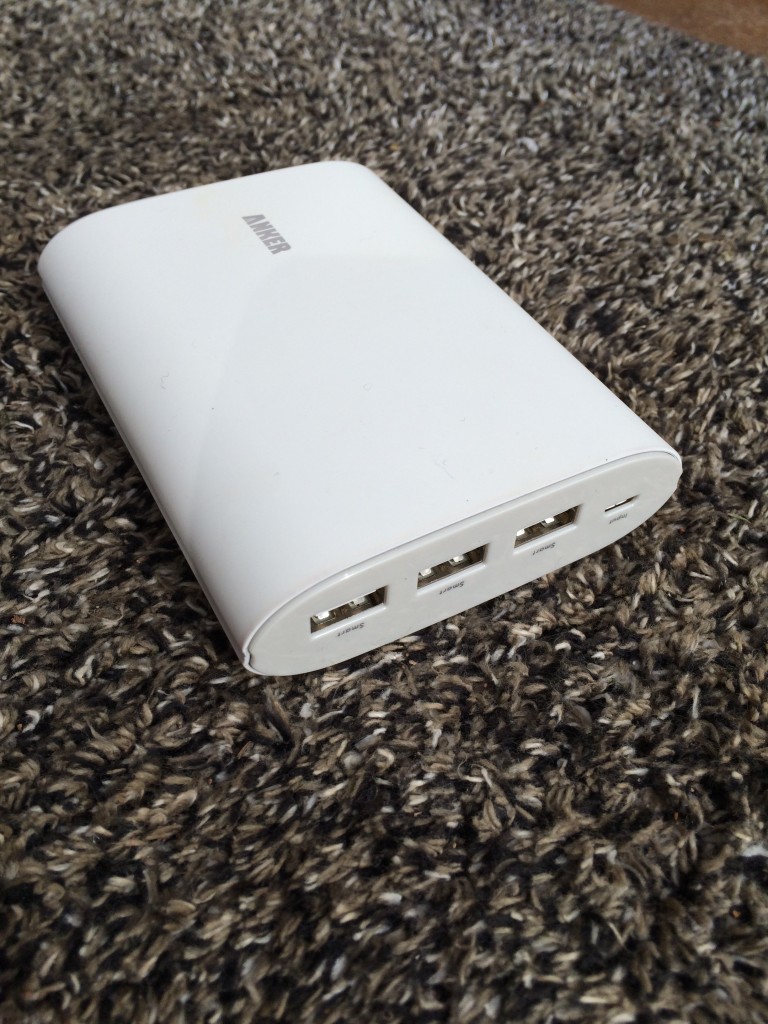So how did I keep all this technology powered up?
The biggest drawback with reliance on so much technology was the need to have access to electricity to keep everything going.
I had to make sure that I could quickly and easily charge up my various electronic devices whenever I could get access to a mains power outlet. I also had to make sure that I would still have enough power to keep me going for a few days, even if I couldn’t get access to the mains. And, finally, I wanted to make sure I had backup, in case my main charging system failed for any reason.
And well as doing all this, I need to keep weight down, as everything I thought I might need to minimise the risk of running out of power, I knew I would have to carry on my back.
In the end, I picked an Anker 40W, 5xUSB port smart charger as my main charging device. Because my Asus tablet laptop was powered via a micro-USB port, it meant that I could charge my laptop, iPhone and iPad simultaneously from the same charger, without needing to carry lots of different chargers for each device, and needing to find lots of power sockets to plug them all in.

I became obsessive about finding power outlets wherever I stopped, on the principle that I didn’t know when and where the next one might be. So if I stopped in a café, the first thing I would do was find a plug. And in the evenings, if I went to the pub, the first thing I did even before buying a pint was to find a plug. Normally I managed this, though some pubs were reluctant to let me use their sockets for regulatory reasons. If I could get power in the evening, in the 2 or 3 hours I spent in the pub, I could easily charge all my devices, and any spare batteries that I’d used, up to 100%.

To cover the risk that I couldn’t get to mains power, I carried external rechargeable Li-ion batteries. Initially I carried two of these spare batteries, but when I reached the far north of Scotland, I stocked up with additional batteries and ended up carrying five. They weighed a lot (well 1.5 kg / 3.5lb) altogether but I reckoned that I would have enough power with me to keep everything fully charged for about a week, and maybe a bit longer, if I was careful. In the end, I never actually needed to use more than two of the batteries, as I could generally get to outlet power every other day even in the remotest spots.

These external batteries had three USB ports, meaning that I could charge iPhone, iPad and laptop all at the same time – greatly saving space and adding convenience.

I don’t believe in taking risks – so I had further backups in case all this kit failed. First of all, I carried a “Mu” folding USB charger plug. This lightweight, rather neat, bit of kit was handy to carry and, with suitable adapters, could charge most of my devices, though it struggled to charge the laptop and iPad fully and was very slow (newer models are better and specifically designed to charge up tablets).

I wasn’t satisfied by all this redundancy, so, as a final resort, I took with me a charger which could use AA disposable batteries. I reckoned that even if I couldn’t get to mains power, I would be able to buy AA batteries from somewhere, so this was my last resort. You can’t buy devices like this, so I’d made one from various bits of electronic kit and a cigarette lighter adapter. In the end I never used it on the walk, though I knew it would work as I had used it a couple of years earlier, on a backpacking hike along the West Highland Way, and it was reassuring to know it was there in case I ever needed it.

All this kit added a lot to the weight I was carrying – I think I could have been carrying as much as 2.5kg / 6 lb of chargers, batteries and connectors – possibly more weight of electricity than food!
Most of this of course wouldn’t have been necessary if I’d used paper maps (though I’d have been carrying a ton of maps instead) or not been obsessed with writing a blog. If I were doing the exact the same walk again, I wouldn’t change much, except probably to just take two spare batteries, and ditch the AA powered charger.
